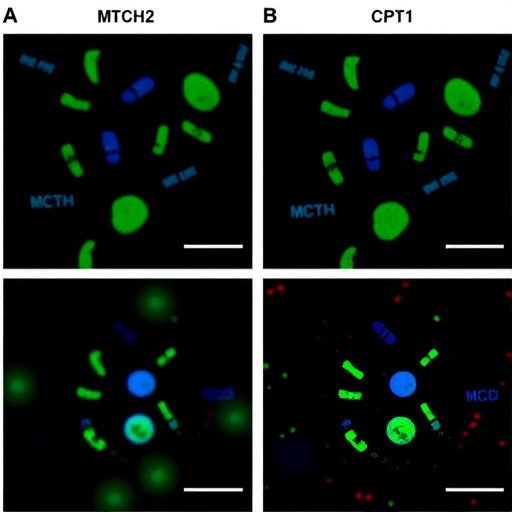In a groundbreaking study published in Nature Communications, researchers have unveiled a pivotal mechanism behind lipid metabolism regulation in adipocytes, centered around the mitochondrial protein MTCH2 and its influence on CPT1 activity. This discovery opens new avenues for understanding metabolic diseases such as obesity and type 2 diabetes, potentially guiding innovative therapeutic strategies aimed at energy homeostasis and lipid utilization.
Adipocytes, or fat cells, are critical players in lipid storage and energy regulation, maintaining a delicate balance between lipid accumulation and fatty acid oxidation. The modulation of these opposing processes ensures energy availability during fasting or increased demand. Central to fatty acid metabolism is the mitochondrial enzyme carnitine palmitoyltransferase 1 (CPT1), which facilitates the transport of long-chain fatty acids into mitochondria for β-oxidation — a crucial step in energy release from fats.
MTCH2, or Mitochondrial Carrier Homolog 2, previously implicated in mitochondrial dynamics and apoptosis, has now emerged as a key regulator of CPT1 activity. The study by Wu et al. systematically dissects the interaction between MTCH2 and CPT1, demonstrating that MTCH2 directly modulates CPT1 function to effectively orchestrate lipid catabolism within adipocytes. This fine-tuning capability positions MTCH2 as a metabolic gatekeeper influencing cellular energy flux.
Methodologically, the research utilized a combination of genetic knockout models, biochemical assays, and high-resolution imaging to dissect the regulatory axis of MTCH2 and CPT1. By knocking out MTCH2 in murine adipocytes, the team observed a marked decrease in CPT1 enzymatic activity, accompanied by impaired fatty acid oxidation and consequent lipid accumulation. These results underscore MTCH2’s essential role in sustaining mitochondrial fatty acid uptake and oxidation efficiency.
Further biochemical interrogation revealed that MTCH2 influences CPT1 activity through physical interactions that modulate its conformation and catalytic efficiency. Structural modeling complemented by co-immunoprecipitation experiments confirmed that MTCH2 binding enhances CPT1’s accessibility to its substrates, facilitating increased fatty acid translocation across the mitochondrial membrane. This molecular insight advances our comprehension of mitochondrial metabolic control points.
Significantly, the metabolic consequences extend beyond isolated cellular models. In vivo analyses in MTCH2-deficient mice manifested with altered adipose tissue lipid profiles, increased lipid droplet size, and systemic metabolic disturbances such as insulin resistance. These phenotypic adaptations mirror those seen in metabolic syndrome, reinforcing the clinical relevance of the MTCH2-CPT1 axis.
On a broader physiological level, the study links MTCH2 to energy homeostasis during nutrient scarcity. Under fasting conditions, when fatty acid oxidation is paramount, MTCH2 expression and function were upregulated, coinciding with enhanced CPT1-mediated β-oxidation. This dynamic adjustment highlights MTCH2’s adaptability in coordinating energy supply-demand balance.
The findings also shed light on the intricate crosstalk between mitochondrial carriers and lipid metabolism enzymes, challenging the traditional view of these proteins as mere transporters. MTCH2 exemplifies the emerging concept of mitochondrial carrier proteins as integral modulators of enzymatic pathways, which have profound implications for cell metabolism regulation.
Notably, the elucidation of MTCH2’s role may catalyze novel pharmacological approaches aimed at controlling lipid metabolism in obesity and diabetes. Targeting MTCH2 to boost CPT1 activity could enhance fatty acid oxidation, reduce lipid overload in adipocytes, and improve insulin sensitivity — a therapeutic angle with promising translational potential.
Moreover, the study’s comprehensive approach integrates molecular biology, physiology, and biochemistry, providing a holistic depiction of metabolic regulation in adipose tissue. Such interdisciplinary methodologies pave the way for future investigations into mitochondrial protein networks influencing cellular metabolism.
This research adds a new chapter to the narrative of mitochondrial bioenergetics, demonstrating how mitochondrial carriers extend beyond transportation to modulate pivotal enzymatic activities. MTCH2 stands out as a molecular sentinel, adjusting mitochondrial fatty acid influx and orchestrating metabolic responses tailored to cellular energy demands.
In conclusion, Wu and colleagues’ work establishes MTCH2 as a crucial modulator of CPT1 activity and lipid metabolism in adipocytes. Their findings illuminate fundamental aspects of energy regulation at the mitochondrial interface, holding significant implications for metabolic disease understanding and treatment development. As obesity and diabetes rates escalate globally, insights into such molecular mechanisms become ever more urgent and impactful.
By unveiling these intricate biochemical interactions, this study not only deepens our grasp of adipocyte metabolism but also inspires future research into mitochondrial protein functions that transcend canonical roles. As the field progresses, targeting protein regulators like MTCH2 may become a cornerstone in metabolic disease management.
The discovery further emphasizes that metabolic regulation is exquisitely controlled at multiple levels, including protein-protein interactions within organelles. This nuanced control underlies cellular flexibility in energy utilization, critical for organismal survival under fluctuating nutrient conditions.
In essence, the MTCH2-CPT1 axis constitutes a novel regulatory hub, uniting mitochondrial transport with enzymatic activity modulation to finely adjust adipocyte lipid metabolism. This paradigm enriches our understanding of the molecular choreography sustaining metabolic health, potentially guiding the next generation of metabolic therapeutics.
Article References:
Wu, C., Wang, T., Ghosh, A. et al. MTCH2 modulates CPT1 activity to regulate lipid metabolism of adipocytes. Nat Commun 16, 8831 (2025). https://doi.org/10.1038/s41467-025-63880-7
Image Credits: AI Generated




